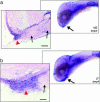Integration and evolution of the cichlid mandible: the molecular basis of alternate feeding strategies
- PMID: 16251275
- PMCID: PMC1283439
- DOI: 10.1073/pnas.0506649102
Integration and evolution of the cichlid mandible: the molecular basis of alternate feeding strategies
Abstract
African cichlid fishes have repeatedly evolved highly specialized modes of feeding through adaptations of their oral jaws. Here, we explore the molecular genetic basis of the opening and closing lever mechanisms of the cichlid lower jaw, which have traditionally been used to describe the mechanics of feeding behavior in bony fishes. Quantitative genetic analyses demonstrate that the opening and closing mechanisms are genetically modular and therefore free to evolve independently. Bmp4 (bone morphogenetic protein 4) is one of two loci that segregate with the mechanical advantage of closing and that together account for >30% of the phenotypic variance in this trait. Species-specific differences in jaw shape are obvious early in cichlid larval development and are correlated with patterns of bmp4 expression in the mandibular primordium. When bmp4 is overexpressed in the obligate suction feeder Danio rerio, mandibular morphology exhibits specific transformations of opening and closing lever ratios. We conclude that patterns of morphological integration of the cichlid jaw reflect a balance among conflicting functional demands. Further, we demonstrate that bmp4 has the potential to alter mandibular morphology in a way that mimics adaptive variation among fish species.
Figures






References
-
- Wainwright, P. C. (1996) Ecology 77, 1336-1343.
-
- Wainwright, P. C. & Shaw, S. S. (1999) J. Exp. Biol. 202, 3101-3110. - PubMed
-
- Motta, P. J. (1988) Environ. Biol. Fishes 22, 39-67.
-
- Wainwright, P. C., Bellwood, D. R., Westneat, M. W., Grubich, J. R. & Hoey, A. S. (2004) Biol. J. Linn. Soc. 82, 1-25.
-
- Westneat, M. W. (1995) Syst. Biol. 44, 361-383.
Publication types
MeSH terms
Substances
Grants and funding
LinkOut - more resources
Full Text Sources
Other Literature Sources

